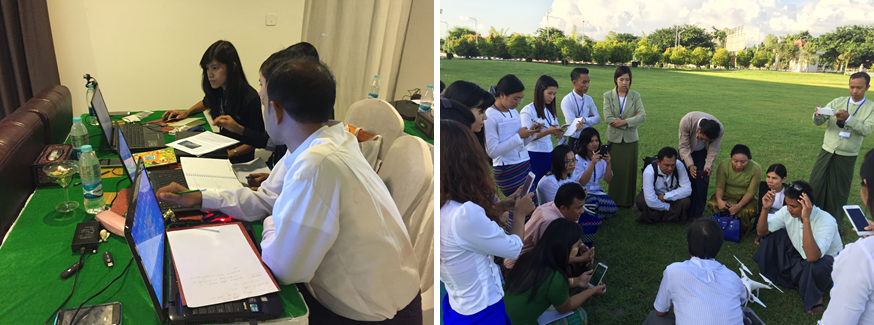Leveraging the use of Geospatial Information Technology for DRR in Southeast Asia
19 December, 2016, Nay Pi Taw, Myanmar - UNOSAT in partnership with the Asian Disaster Preparedness Center (ADPC) successfully delivered two weeks of in-country training in Nay Pi Taw, Myanmar benefiting 40 technical professionals drawn from various line ministries of Myanmar including the Department of Meteorology and Hydrology, the Remote Sensing Department Relief and, the Resettlement Department. The two trainings: “Introduction to Geospatial Information technology for Disaster Risk Reduction” and “Advanced Application of Geospatial Information Technology for Decision Support related to Disaster Risk Reduction took place from 17 to 21 October and 05 to 09 December, 2016 respectively. The overall aim of the trainings was to increase the capacity of the Myanmar government on the use of Geographic Information Systems (GIS) applications for Disaster Risk Reduction (DRR).

The training in Myanmar was delivered within the framework of the capacity development project entitled: “Building Capacities for Disaster Risk Reduction using Geospatial Technologies in Southeast Asia Region” implemented by UNOSAT in collaboration with ADPC. Since its inception in 2011, the project has successfully implemented 6 international GIS training courses in Bangkok, Thailand and 7 in-country trainings in Dhaka, Bangladesh; Phnom Penh, Cambodia; Nay Pi Taw, Myanmar and Hanoi, Vietnam profiting 300+ GIS professionals in the region. In 2016, Myanmar was targeted as a beneficiary of the in-country training as it is one of the vulnerable countries in the region with a high risk of exposure to natural disasters.
The two weeks training presented the participants with an innovative capacity development approach that enabled them to master and adopt the different tools and techniques of Geospatial Information Technology (GIT) in their daily workflows. According to the feedback from participants, the training was 100% successful and it provided a motivational boost to make the participants confident to apply the GIT knowledge and skills acquired in their professional setting. From the participants’ observation, the exercise in the training manual and technical support provided by UNOSAT were essential in facilitating them in the development of the mini projects.
Mir Khin Thandar Tun of the Myanmar Information Management Unit (MIMU) emphasised that:
“The topics on Disaster Risk Reduction and Earthquake were very practical especially because we had a chance to learn the usage of software applications in addressing disasters”.
The Community of Practice established at the end of the first training enabled the participants to have personal communication among themselves on solutions of tackling their day-to-day challenges in the application of GIT to their work. Since the first training, UNOSAT has continued to backstop the trainees with advice and access to data, as well as 1 year ArcGIS license from ESRI to support the application of the knowledge and skills gained from the course to their work.
The in-country training programme in Southeast Asia is funded by The Norwegian Ministry of Foreign Affairs and is focused on strengthening capacities on the use of Geographic Information Systems (GIS) for Disaster Risk Reduction (DRR).
Photo 1: Participants in a GIS laboratory
Photo 2: Participants during the field data collection exercise with UNOSAT’s expert Mr. Khaled Mashfiq explaining data collection procedures using the UN-ASIGN App

